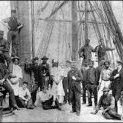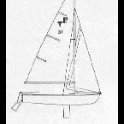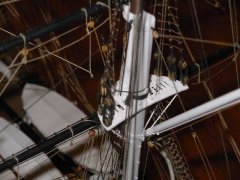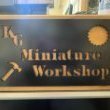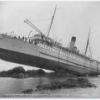-
Posts
660 -
Joined
-
Last visited
Reputation Activity
-
 rvchima got a reaction from mtaylor in Bismarck by rvchima - FINISHED - Amati - Scale 1:200 - WWII German Battleship
rvchima got a reaction from mtaylor in Bismarck by rvchima - FINISHED - Amati - Scale 1:200 - WWII German Battleship
John,
I have kept plans from every model that I've made since I was a teenager, so I am not interested in selling the Bismarck plans. The Amati plans comprise two full-color glossy books with 210 pages total and seven full-sized drawings. You might try to get them from Amati. There is a full set of how-to-build the Hachette Bismarck videos on YouTube. This may be enough to get it built.
-
 rvchima got a reaction from Ian_Grant in Bismarck by rvchima - FINISHED - Amati - Scale 1:200 - WWII German Battleship
rvchima got a reaction from Ian_Grant in Bismarck by rvchima - FINISHED - Amati - Scale 1:200 - WWII German Battleship
The Best Laid Plans ...
I rushed to finish my display case before my son came for our July 4th holiday. We have a nice, finished attic, and my plan was that he and I could carry it up there where it would not clutter up the living areas of our house. We moved it awkwardly from the basement to the second floor entrance to the attic stairs, where there is a full-sized door followed immediately by a steep staircase. Wouldn't you know it, but when we angled the case to go up the stairs it would not fit under the door frame. We studied the situation for a long time and finally decided that that the case was not going in the attic. Luckily we have a guest bedroom on the second floor with room for a display case, and that's where it ended up.
My glass shelves and doors all fit perfectly (whew), and so did the three models. The Bismarck and Prinz Eugen are both 1/200 scale, and the Arleigh Burke is 1/196 so they look good together. I could probably squeeze my U-boat in there too but at 1/72 it might look out of place.
I put rows of LED light strips over each model. They are very intense, impossible to photograph, and I'll probably never use them.
My advice to anyone planning to build cabinets for large models:
Make separate cabinets for each model Make them stackable like an old Barrister's bookcase Forget the LED lights -
 rvchima got a reaction from Ian_Grant in Bismarck by rvchima - FINISHED - Amati - Scale 1:200 - WWII German Battleship
rvchima got a reaction from Ian_Grant in Bismarck by rvchima - FINISHED - Amati - Scale 1:200 - WWII German Battleship
Display Case
I am building a display case for my three warship models - the Bismarck, Prinz Eugen, and Arleigh Burke. I started trying to model it in Sketchup, which I have used before. I wasn't happy with my original design so I started over with some simple sketches, and finished with a hand-drawn 3-view. I took a LOT of drawing in high school and one class in college, which immediately became obsolete- except when I want to make something. Here's my final 3-view from 8 days ago.
You can see that this is a BIG piece of furniture. The Bismarck is 50" long, but acrylic sells in 48" sheets, so that set the width. The Bismarck will be hidden a little behind the frames. The models are all around 14" high, so there will just be enough height for the three.
Later I went back to Sketchup and got some better views.
Last Friday I went to the lumber yard and bought $400 worth of cherry. Here's what I've finished since then.
A few days ago I ordered hardware and LED lights: $150.
Today I ordered 2 glass doors for the sides and 2 glass shelves: $225.
I also bought the acrylic front panel $115.
I haven't added it all up yet, but I think it was WAY more than I ever expected to spend on a display case. It will keep the dust off of three models, but right now my shop in our finished basement is covered with dust. Final photos soon.
-
 rvchima got a reaction from hof00 in Sopwith Camel by rvchima - Artesania Latina - 1/16 scale
rvchima got a reaction from hof00 in Sopwith Camel by rvchima - Artesania Latina - 1/16 scale
I just finished a "skeleton" model of a Sopwith Camel, you know the one that Snoopy flies. It is a 1/16 scale kit made by Spanish company Artesania Latina. The instruction manual is a pdf file 267 pages long with no text, only photos, so I had to keep my laptop on for 4 months while I built the model. The wood parts are perfectly laser cut. The kit has lots of cast metal parts. The casting is excellent but the parts often don't quite fit together, making it a frustrating build. And it makes me crazy to have cast metal tires, cowling, and wood panels around the cockpit. There are also lots of photo-etched parts like all the turnbuckles that have to be folded in complicated mirror-image shapes. You only get one chance because the parts break if you have to unfold them. The kit came with black monofilament line for the rigging that simply couldn't be tied through the tiny PE parts, and some other fuzzy cotton thread for an unknown use. Luckily I have plenty of spare rigging line. Many years ago I built a similar model of a Fokker triplane "Curse you Red Baron!" but by Model Airways. The models are the same scale and look great together. -
 rvchima got a reaction from catopower in F4-D Phantom - Dumas - FINISHED - 1/25 Scale
rvchima got a reaction from catopower in F4-D Phantom - Dumas - FINISHED - 1/25 Scale
I just finished a "stick and tissue" model of an F4-D Phantom jet in Vietnam camouflage. The kit is made by Dumas Products. They make a nice range of boat kits, rubber-powered aircraft kits, and also a couple of static scale aircraft kits like this one. The kit comes with a nice selection of light-weight balsa, vacuum-formed accessories, and four colors of tissue for covering. Since it will never fly I decided to cover it instead with iron-on Oracote, and since Oracote shrinks very tight I replaced all the stringers with much heavier balsa. Here's the frame before covering:
I air brushed the model with Vallejo acrylics, and used Silly putty to mask the camouflage. There are LOTS of YouTube videos that recommend Silly Putty, but I had a lot of trouble with it. Remember when you were a kid and used Silly Putty to lift images out of comic books? Well if you leave it on acrylic paint overnight it lifts some paint and leaves a darker streak. I had to repaint most of my camo. If you remove it immediately it works OK. Here's the paint job in progress:
The model is 1/25 scale and 28 inches long, basically "drive-by scale." It looks pretty good if you drive by slowly.
-
 rvchima got a reaction from Stevinne in Bismarck by rvchima - FINISHED - Amati - Scale 1:200 - WWII German Battleship
rvchima got a reaction from Stevinne in Bismarck by rvchima - FINISHED - Amati - Scale 1:200 - WWII German Battleship
Rigging
I finished the rigging yesterday and am working on the handrails. It's all done with 0.2 mm black monofilament line, which has been a pleasure to work with. It's extremely strong, doesn't kink, and glues solid with a spot of CA.
There are 4 double antennas tied to tiny triangular PE pieces. I clamped the pieces to a stick to get the two lines the same length.
Here's the rigging in all its glory. I left this photo at full resolution so you can see the lines.
The handrails comprise about 150 PE stanchions on each side of the ship threaded with three layers of monofilament line. I was dreading this task, but it's only taking about one hour per line. You can literally pull one end of the line and tighten it the entire length of the ship.
I finally made a new base for the model using purpleheart wood. The color looks good with the anti-rust color of the lower hull, and it will turn a little browner with age.
-
 rvchima got a reaction from Javlin in Bismarck by rvchima - FINISHED - Amati - Scale 1:200 - WWII German Battleship
rvchima got a reaction from Javlin in Bismarck by rvchima - FINISHED - Amati - Scale 1:200 - WWII German Battleship
Bismarck by rvchima - Amati - Scale 1:200 - WWII German Battleship - FINISHED
530 Hours, 225 Days
The Bismarck is finished and my bench is cleared off, ready to start a new project. I kept a "diary" of my build, and it took me about 530 hours over 225 days. I took off a couple of weeks around the holidays and all of March, so on average I put in about 3 hours per day. Your mileage may vary.
This is the most expensive kit I've ever bought at close to $700 US. I also spent around $200 for brass props, glue, paints, and pedestals and wood for the base, so my hobby cost about $5 per day. My wife is happy that I'm not into real boats.
This is also one of the nicest kits I've ever built. The wood is excellent, the laser cutting is perfect, and the photo etched parts are superb. The two instruction manuals are the best I've ever seen. The plastic parts were not quite as good. Some had molding cavities that had to be filled, and the many staircases were made from some more flexible plastic that did not glue well. I've made three kits by Amati now - their Bismarck, U-boat 47, and Arno XI Ferrari hydroplane. They were all excellent kits, and I highly recommend any of them.
Final Photos
All guns to starboard.
The Bismarck with the Prinz Eugen "light" cruiser by Aeronaut, both at 1/200 scale.
The Bismarck is on the mantle at the moment but won't remain there long. Probably only until my wife comes downstairs.
-
 rvchima got a reaction from gsdpic in Robert E Lee by rvchima - FINISHED - Amati - scale 1:150 - Mississippi River Steamboat 1866 - 1876
rvchima got a reaction from gsdpic in Robert E Lee by rvchima - FINISHED - Amati - scale 1:150 - Mississippi River Steamboat 1866 - 1876
Steamboat Robert E Lee is Finished, 269 Hours, 102 Days
Since returning from a trip to Utah to visit five national parks, I've put in about 40 hours to complete the rigging, accessories, and deck furniture. Here are photos of the final model.
The masts and yards were fairly complicated, with the hinged joints between them made up from brass tube and sheet. The chain supplied for the gangways is tiny and required magnifiers to work with. The gangways would never hang in place by themselves so I glued small black wedges to keep them were I want them.
The kit includes two very nice metal and wood anchor kits and a really cute turned capstan. The instructions said to use 1 mm wood strips for the capstan bars, but the turned base had 1 mm round holes so I used brass rod. When I clipped the rod to length after assembly the ends were rough so I touched one gently to my disk sander, and the sander grabbed it and dragged the whole thing into the gap between the spinning disk and table. That really mangled the capstan. I sure wish I had taken a photo.
I ended up turning a new capstan on the end of a dowel. Here's the new one and what's left of the old one.
The ship has two tiny lifeboats for 240 or more passengers, and no davits for launching them.
There is one more lifeboat or ship's boat hanging from a boom at the stern. Like the gangways there is no way this would hang correctly by itself, so I pinned it to the stern.
Summary
You can't go wrong with a kit by Amati. They have excellent materials and detailed plans, and end up as beautiful models.
The illustrated instructions for the Robert E. Lee are in Italian. An English translation is included but you need to refer back to the Italian for illustrations. The build sequence was confusing. Instead of building cabins upward from the lower deck, they are built down from the deck above. That allows you to plank and paint the cabin walls, but it makes it quite confusing to see which parts all need to line up. The instructions recommended rounding the edges of the cabin wall planks. I regret doing that on the lower decks - the paint didn't get into the joints and it makes the work look sloppy. I did not round the planks on the upper decks. You can still see hints that the walls are planked but they look much cleaner. I also found that I could pre-glue several planks to a sheet of brown paper, glue that to the cabin walls, and trim the length later. That gave a much neater look.
This is not an easy model. All the planking, windows and doors, and a surprising amount of rigging add up to a lot of work. In the end, though, Amati's Robert E Lee builds into a beautiful model.
-
 rvchima got a reaction from etubino in U-47 1936 by rvchima - FINISHED - Amati - 1:72 - PLASTIC - Type VIIB U-Boat
rvchima got a reaction from etubino in U-47 1936 by rvchima - FINISHED - Amati - 1:72 - PLASTIC - Type VIIB U-Boat
A Little Progress, 7 hours over 7 days
I started by making a temporary stand from poplar. The kit came with nice brass pedestals. I found some bolts that fit them, drilled holes in the hull and epoxied nuts in place.
The laser-cut parts for the superstructure popped right out of the surrounding wood, but they didn't quite fit in the space atop the resin hull. I had to do some cutting and sanding to make them fit. The resin hull seems solid but it sands like Styrofoam and is very easy to shape.
And that is the end of the wood work on this model.
The superstructure will be covered with photo-etched parts with lots of holes, so I painted the interior black.
-
 rvchima got a reaction from etubino in U-47 1936 by rvchima - FINISHED - Amati - 1:72 - PLASTIC - Type VIIB U-Boat
rvchima got a reaction from etubino in U-47 1936 by rvchima - FINISHED - Amati - 1:72 - PLASTIC - Type VIIB U-Boat
Amati U-Boat 47 type VIIB
After building the Syren I didn't want any more rigging. After building the Arno XI Ferrari hydroplane I didn't want any more brass nails in the deck. After building the Anteo harbour tug I didn't want another double-planked hull. What to build next??? A submarine!
Amati offers an attractive kit of a German U-boat from 1939. You can get it for £225.00 from westbourne-model.co.uk, but I found one on eBay for much less. I've had the kit for 6 months and am finally getting started.
What's in the Box
The meter long box has two divided plastic bins on the sides and one large area in the center for flat materials. The bottom contains a cast resin hull of the submarine.
The full-sized plans are about 0.7m x 1 m, and are all in Italian. The hull seems to be two hollow pieces glued together, but I can't find obvious seams. Alas, there are no rivets, panel lines, or other details molded in the hull.
There is one sheet of laser-cut plywood parts used to build up the superstructure of the deck. There is also a heavy cardboard sheet, apparently used to identify the plywood parts.
There is also a large sheet of photo-etched brass parts used to make all the of the detail on the deck. It seems to be beautifully detailed.
One parts bin contains a resin cast conning tower, dive planes, and some miscellaneous small parts. The kit does contain two turned brass mounting pedestals but no wood base.
The other parts bin has a decal, and a nice cast sailor and anchor. The props and mounting hardware are, disappointingly, plastic.
The instructions are 16 pages long and are written in Italian. But like Lego instructions they are mostly pictures, so I don't think they will be too hard to follow. The English translation is about 1.5 pages long.
I'll be starting on this after the holidays. Stay tuned for more.
-
 rvchima got a reaction from kgstakes in Robert E Lee by rvchima - FINISHED - Amati - scale 1:150 - Mississippi River Steamboat 1866 - 1876
rvchima got a reaction from kgstakes in Robert E Lee by rvchima - FINISHED - Amati - scale 1:150 - Mississippi River Steamboat 1866 - 1876
Happy Independence Day to My Followers in the US!
This bad boy wandered through my yard this morning looking for a cookout.
-
 rvchima got a reaction from kgstakes in Robert E Lee by rvchima - FINISHED - Amati - scale 1:150 - Mississippi River Steamboat 1866 - 1876
rvchima got a reaction from kgstakes in Robert E Lee by rvchima - FINISHED - Amati - scale 1:150 - Mississippi River Steamboat 1866 - 1876
Hull Construction
The hull is pre-built out of 1.5" thick clear white pine. The bow and stern must be slightly raised using pieces of 1mm ply that are stacked, sanded, and glued in place.
Bow and stern pieces stacked,
sanded,
and glued in place.
Step 2 - Paint the Hull!
I have never completed a hull so quickly! But after some rare forethought I realized that it might be wise to build the rudder first.
Step 2a - Rudder
The rudder is attached to a keel post that didn't come close to fitting the hull. I had to reshape the hull, drill a hole for the rudder post, and make a new keel to fit.
Original keel
Reshaped hull with rudder in place.
New keel cut to fill the hole.
The brass rudder hinges are absolutely beautiful.
Assembled rudder.
-
 rvchima got a reaction from Thukydides in Robert E Lee by rvchima - FINISHED - Amati - scale 1:150 - Mississippi River Steamboat 1866 - 1876
rvchima got a reaction from Thukydides in Robert E Lee by rvchima - FINISHED - Amati - scale 1:150 - Mississippi River Steamboat 1866 - 1876
Steamboat Robert E Lee is Finished, 269 Hours, 102 Days
Since returning from a trip to Utah to visit five national parks, I've put in about 40 hours to complete the rigging, accessories, and deck furniture. Here are photos of the final model.
The masts and yards were fairly complicated, with the hinged joints between them made up from brass tube and sheet. The chain supplied for the gangways is tiny and required magnifiers to work with. The gangways would never hang in place by themselves so I glued small black wedges to keep them were I want them.
The kit includes two very nice metal and wood anchor kits and a really cute turned capstan. The instructions said to use 1 mm wood strips for the capstan bars, but the turned base had 1 mm round holes so I used brass rod. When I clipped the rod to length after assembly the ends were rough so I touched one gently to my disk sander, and the sander grabbed it and dragged the whole thing into the gap between the spinning disk and table. That really mangled the capstan. I sure wish I had taken a photo.
I ended up turning a new capstan on the end of a dowel. Here's the new one and what's left of the old one.
The ship has two tiny lifeboats for 240 or more passengers, and no davits for launching them.
There is one more lifeboat or ship's boat hanging from a boom at the stern. Like the gangways there is no way this would hang correctly by itself, so I pinned it to the stern.
Summary
You can't go wrong with a kit by Amati. They have excellent materials and detailed plans, and end up as beautiful models.
The illustrated instructions for the Robert E. Lee are in Italian. An English translation is included but you need to refer back to the Italian for illustrations. The build sequence was confusing. Instead of building cabins upward from the lower deck, they are built down from the deck above. That allows you to plank and paint the cabin walls, but it makes it quite confusing to see which parts all need to line up. The instructions recommended rounding the edges of the cabin wall planks. I regret doing that on the lower decks - the paint didn't get into the joints and it makes the work look sloppy. I did not round the planks on the upper decks. You can still see hints that the walls are planked but they look much cleaner. I also found that I could pre-glue several planks to a sheet of brown paper, glue that to the cabin walls, and trim the length later. That gave a much neater look.
This is not an easy model. All the planking, windows and doors, and a surprising amount of rigging add up to a lot of work. In the end, though, Amati's Robert E Lee builds into a beautiful model.
-
 rvchima got a reaction from schooner in Robert E Lee by rvchima - FINISHED - Amati - scale 1:150 - Mississippi River Steamboat 1866 - 1876
rvchima got a reaction from schooner in Robert E Lee by rvchima - FINISHED - Amati - scale 1:150 - Mississippi River Steamboat 1866 - 1876
Steamboat Robert E Lee is Finished, 269 Hours, 102 Days
Since returning from a trip to Utah to visit five national parks, I've put in about 40 hours to complete the rigging, accessories, and deck furniture. Here are photos of the final model.
The masts and yards were fairly complicated, with the hinged joints between them made up from brass tube and sheet. The chain supplied for the gangways is tiny and required magnifiers to work with. The gangways would never hang in place by themselves so I glued small black wedges to keep them were I want them.
The kit includes two very nice metal and wood anchor kits and a really cute turned capstan. The instructions said to use 1 mm wood strips for the capstan bars, but the turned base had 1 mm round holes so I used brass rod. When I clipped the rod to length after assembly the ends were rough so I touched one gently to my disk sander, and the sander grabbed it and dragged the whole thing into the gap between the spinning disk and table. That really mangled the capstan. I sure wish I had taken a photo.
I ended up turning a new capstan on the end of a dowel. Here's the new one and what's left of the old one.
The ship has two tiny lifeboats for 240 or more passengers, and no davits for launching them.
There is one more lifeboat or ship's boat hanging from a boom at the stern. Like the gangways there is no way this would hang correctly by itself, so I pinned it to the stern.
Summary
You can't go wrong with a kit by Amati. They have excellent materials and detailed plans, and end up as beautiful models.
The illustrated instructions for the Robert E. Lee are in Italian. An English translation is included but you need to refer back to the Italian for illustrations. The build sequence was confusing. Instead of building cabins upward from the lower deck, they are built down from the deck above. That allows you to plank and paint the cabin walls, but it makes it quite confusing to see which parts all need to line up. The instructions recommended rounding the edges of the cabin wall planks. I regret doing that on the lower decks - the paint didn't get into the joints and it makes the work look sloppy. I did not round the planks on the upper decks. You can still see hints that the walls are planked but they look much cleaner. I also found that I could pre-glue several planks to a sheet of brown paper, glue that to the cabin walls, and trim the length later. That gave a much neater look.
This is not an easy model. All the planking, windows and doors, and a surprising amount of rigging add up to a lot of work. In the end, though, Amati's Robert E Lee builds into a beautiful model.
-
 rvchima reacted to schooner in SEGUIN by schooner - FINISHED - BlueJacket Shipcrafters - 1:48 - RADIO - Steam Tug
rvchima reacted to schooner in SEGUIN by schooner - FINISHED - BlueJacket Shipcrafters - 1:48 - RADIO - Steam Tug
21. Ship’s Boat and Final Rigging
The Boat
The instructions call for carving a provided block of wood into a boat shape -that's beyond my skills so I ordered a 3 3/16" britannia boat from blue jacket and covered the top with tracing paper to simulate a canvas covering.
Standing Rigging
For the shrouds and stays I followed the recommendation in the instruction book for the RC option and used black stretch cord (.5mm) that I bought online. To secure them I used .015 inch crimping tubes.
Previous build logs, as confirmed by the plans, reported that the after boat davit is completely blocked by the shrouds on the port side of the aft mast so I moved both davits 1/2” forward. Several build logs reported a problem with the shrouds impinging on the deck house roof. I found that if I anchored them on the inboard side of the cap rail that there was no problem.
The stretch cords, set to be about 1 inch short of their pre-stretched final length, hold the deckhouse firmly in place but are easy to lift off of the hooks on the mast so the house can be removed.
Running Rigging and the flags
The model comes with a gaff boom on each mast. I assumed they were there as part of an emergency “get home” sailing rig. If so, the rigging on the plans did not make much sense to me so I copied the gaff rigging used on my model of the USS Olympia (built at the same time as the Seguin) and added double blocks to the gaff vangs and changed the rigging of the gaffs themselves.
The paper flags are from the kit. I rubber-cemented a piece of aluminum foil onto the back of one half of the flag, leaving a border around it for paper to paper gluing. When dry I placed the halyard in the fold crease and then folded and glued the flag halves together. Two different size dowels were used to impart alternating curved folds. Although the dowels could just as well be used to make the flags hang limply I wanted the Seguin to look as if she is headed down the Kennebec River under a full head of steam to pick up a schooner to tow into Bath for an extortionate fee.
The only thing left to do now is to design and fabricate a launch/recovery/carrying cradle, probably from PVC piping and then conduct the maiden voyage, but that will have to wait until Nov when we get back from a road trip out to the West Coast.
-
 rvchima reacted to schooner in SEGUIN by schooner - FINISHED - BlueJacket Shipcrafters - 1:48 - RADIO - Steam Tug
rvchima reacted to schooner in SEGUIN by schooner - FINISHED - BlueJacket Shipcrafters - 1:48 - RADIO - Steam Tug
20. Upper Deck Details
I did one more bathtub float test, this time with the motor running to make sure there would not be any leakage in the stern tube with the shaft rotating - everything was fine.
I placed the pilothouse in place after setting up the brass railings.
I got a lead on some very nice brass stanchions from RVICHMA’s SEGUIN build log. I bought 2 packs of 10 from the Age of Sail website. 24 gage brass wire fits snugly in the stanchion holes.
The stack is pinned in place and the guy wires use the kit-provided copper wire with crimping tubes to fasten them:
The skylight and the boat davits were easy additions:
This build is almost done with just the masts, rigging and ship’s boat to go.
-
 rvchima reacted to schooner in SEGUIN by schooner - FINISHED - BlueJacket Shipcrafters - 1:48 - RADIO - Steam Tug
rvchima reacted to schooner in SEGUIN by schooner - FINISHED - BlueJacket Shipcrafters - 1:48 - RADIO - Steam Tug
19. Pilot House and Masts
The frame for the pilothouse consists of laser cut base and roof outline, joined by 3 pieces of 1/4” square stock. I added some scrap decking material to the floor.
The 2 aft support columns show thru the window and door so I painted part of them black to make them less obvious. Although the instructions call for 1/4” square stock the plans show 1/8” square stock - I’m glad I went with the 1/4” , it is very sturdy which helped when it came time to bend the sheathing around the frame while glueing.
To shape the 2 laminated pieces I found a spray can with the same radius as the front of the pilot house. After soaking them in hot water and ammonia I rubber- banded them in place and left them overnight:
The steering wheel is britannia metal, its stand is made up of strip wood per the plans. The plans show a chart table and bench, I added a voice tube and engine order telegraph:
Here is the furniture in place:
And here is the completed pilothouse with the roof (and rooster) in place:
As it turned out, almost all the interior details are not visible. It’s pretty dark in there and the sight lines thru the windows block everything but the top of the steering wheel, the voice tube and the bench.
This would be a perfect place for putting acetate in the windows but I left them out for the sake of consistency - I had to forgo glazing the doors and windows on the lower deckhouse so that the heat from the motor and ESC would have a way to vent.
The masts have been tapered and the metal work attached:
The instructions call for attaching the foremast by glueing the bottom to the deck which would work fine for a static model but since this deckhouse needs to be removable I changed the attachment point to a spacer that is glued to the front of the deckhouse and will sit on the deck between the water barrel and the ice box - the mast will be glued and pinned to the spacer which is set at a width that will place the mast at the designed rake:
The aft mast needs a little help securing it. The instructions call for glueing it to the hole in the roof but even for a static model that will not provide much strength when it’s time to tension the rigging since the bottom of the mast is just hanging in the air inside the deckhouse. I put a framework on the underside of the deck that will provide a good glueing surface and that also sets the mast plumb and with the proper rake:
-
 rvchima reacted to schooner in SEGUIN by schooner - FINISHED - BlueJacket Shipcrafters - 1:48 - RADIO - Steam Tug
rvchima reacted to schooner in SEGUIN by schooner - FINISHED - BlueJacket Shipcrafters - 1:48 - RADIO - Steam Tug
18. Steering Gear & Deck Furniture
The push rod between the servo and the rudder needs small brass rod at the ends to fit into the small holes on both arms but such thin rod may bend under pressure so I used an idea I found on a RC website and used a wooden dowel for the majority of it. This model is a little unusual in that the pushrod will remain above the deck but it will not be visible since it will be inside a 3-sided box, 2 of which sat on the fantail of the real SEGUIN to protect the steering ropes. The box hiding the pushrod and the fantail grating will be spot glued with white glue so I can remove them if needed.
The deck furniture is done, with the exception of the boat. The fore and aft bitts, the ice chest, the stack and the skylight are per the plans. The kit provides a resin piece for the water barrel but I’ve had several wooden ones from Model Expo in my stash since my first build, as it turns out they are a perfect match for the plans so I used one.
Next up will be the Pilothouse.
-
 rvchima reacted to ccoyle in HMS Fly by ccoyle - FINISHED - Amati/Victory Models - 1/64
rvchima reacted to ccoyle in HMS Fly by ccoyle - FINISHED - Amati/Victory Models - 1/64
Rather than spend a great deal of time creating spare masts to stow the ship's boat on, I decided to display the boat on the stand. I glued down a couple of pieces of strip wood with a slot between them to hold the boat's keel.
I had planned to install the hammock cranes, but I've discovered (or perhaps rediscovered) that the cranes came with the upgrade kit, not the original kit, and there are thus no cranes shown on the plans. I will have to peruse some other build logs to figure out the spacing for them.
-
 rvchima reacted to ccoyle in HMS Fly by ccoyle - FINISHED - Amati/Victory Models - 1/64
rvchima reacted to ccoyle in HMS Fly by ccoyle - FINISHED - Amati/Victory Models - 1/64
I added stump masts today. I think these make a huge visual difference, as now the knowledgeable viewer knows this is supposed to be a hull model and is not simply an unrigged model.
BTW, I did not glue the masts in, just in case I ever get a wild hair and decide to add real masts -- an unlikely event, I feel, but one never knows.
-
 rvchima reacted to ccoyle in HMS Fly by ccoyle - FINISHED - Amati/Victory Models - 1/64
rvchima reacted to ccoyle in HMS Fly by ccoyle - FINISHED - Amati/Victory Models - 1/64
Don't Get Too Excited
Yes, I have decided to resurrect this long-dormant and neglected build log. First, a little back story: I corresponded with Chris Watton during the development of this kit and was thus was one of the first to buy it when it hit the market all the way back in 2006. I got started on it right away and made pretty good progress at first. Now, even during my most prolific modeling outbursts, there are times when a kit just doesn't get the juices flowing like it used to and gets moved to the back burner. Being a square-rigged ship and all the work that entails, Fly has suffered a number of stints on said back burner, and the current spell has been very long indeed -- going on ten years. 😯 In addition, she has endured six moves (including one cross-country), and -- as might be expected -- she hasn't come through all of those moves completely unscathed.
So, why has Fly never got around to being finished? The primary reason is one that I'm sure some of you can relate to: I'm simply not satisfied with the way she has turned out so far, and that kind of puts a crimp on any desire to complete a model I know I won't be completely happy with. The two things that I particularly dislike about my work so far are first of all that I didn't do a good planking job, and as a result the model has quite a few gaps between planks. Second, I don't like the color. The kit came with dark walnut strips for the second planking, and for reasons that I can no longer recall, I stained those even darker. Since that time, I have decided that I like lighter-colored hulls better. Oh, well. Lastly, there is the not-insignificant consideration that a finished Fly would take up a lot of display space, and why devote precious space to a model that doesn't make you proud?
So, after much thought I decided I would eventually finish Fly as a hull model, and now seems as good a time as any to finally tick this task off my to-do list. The first things to do will be to dust the model off, repair the present damage (notably to guns and their rigging), figure out where I left off in the build sequence, and then decide how much detail I will add before finally deciding that Fly will be done enough to call done.
So, enjoy what is left of this journey!
-
 rvchima reacted to ccoyle in HMS Fly by ccoyle - FINISHED - Amati/Victory Models - 1/64
rvchima reacted to ccoyle in HMS Fly by ccoyle - FINISHED - Amati/Victory Models - 1/64
So, here is what the hull looks like as of July, 2012.
Expect more updates on the hull on ... gosh, I don't know. Sometime this year. Maybe.
-
 rvchima reacted to ccoyle in HMS Fly by ccoyle - FINISHED - Amati/Victory Models - 1/64
rvchima reacted to ccoyle in HMS Fly by ccoyle - FINISHED - Amati/Victory Models - 1/64
This is the aforementioned forward screen bulkhead, along with a view of the two ladders that had to be built from scratch because the kit didn't include enough ladder material.
I also added some detail to the gallows, using a file and some scrap card and wood to add beveling, decorative panels, and cheek blocks.
-
 rvchima reacted to ccoyle in HMS Fly by ccoyle - FINISHED - Amati/Victory Models - 1/64
rvchima reacted to ccoyle in HMS Fly by ccoyle - FINISHED - Amati/Victory Models - 1/64
This lovely photo shows what happens when you think you've done an adequate job of planking, only to have the flash show up every ugly gap in the planking. Next time...must do a better job next time. Anyways, the stern carvings are a decent casting. After painting with the basic ochre color, I brought out some detail with some washes. Of course, the flash then proceeded to wash out all the wash detail. The curtains are an idea I copied from another build long ago. The period after 'FLY' is period-appropriate (no pun) and is not included in the PE brass set. It's just daubed on with a brush.
-
 rvchima reacted to ccoyle in HMS Fly by ccoyle - FINISHED - Amati/Victory Models - 1/64
rvchima reacted to ccoyle in HMS Fly by ccoyle - FINISHED - Amati/Victory Models - 1/64
Another couple of tweaks to the kit. The cleats in the kit are far to large, so I cobbled together some smaller replacements.
The kit's binnacle is also very, very basic, so out that went, too. I built a replacement based on some drawings and pics submitted by MSW members. The binnacle lantern is made from a sacrificed CA glue Z-tip, the compass roses are some scaled-down images from the Internet, and the chimney is some part from the scrap bin. The chimney should be black, but I haven't had much success blackening turned brass parts, so I left it shiny. Don't tell anyone.




